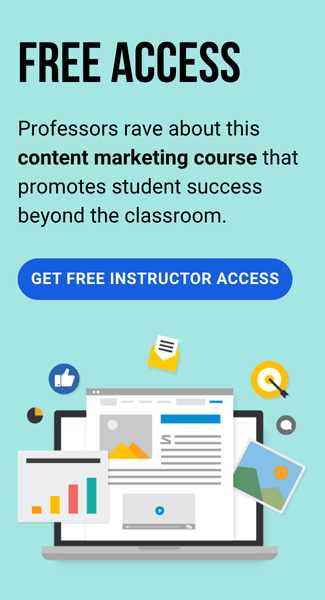From first drafts to final edits, artificial intelligence is transforming how content marketers plan, produce, and publish digital content. Brands are using tools such as ChatGPT and Jasper to draft blog posts, generate SEO-focused outlines, create social media captions, and produce personalized emails at scale.
According to Sprout Social, marketers are using AI to improve content quality, accelerate production, and enhance personalization, leading to stronger engagement and long-term loyalty. In short, AI is becoming a standard part of the content workflow.
For educators teaching content marketing, this shift brings a new sense of urgency. Students are entering a workforce where AI tools are not only acceptable but expected. Yet many classrooms still focus on traditional campaign building without addressing how technology is reshaping the field.
This blog explores how AI is being used in content marketing today — and what that means for instructors. From teaching prompt writing to critiquing AI-generated copy, marketing professors play a vital role in preparing students who can think critically, write creatively, and lead strategically — even with AI in the room.
How AI Is Reshaping the Content Marketing Workflow
Across the content life cycle, AI is helping marketers accelerate workflows, scale output, and personalize messaging, all without losing creative control. It’s changing the how of content creation, not the why.
AI Helps Marketers Move Faster and Smarter
According to Sprout Social, AI enables faster campaign delivery, stronger customer insights, and more targeted messaging. That helps brands increase reach, strengthen engagement, and maintain a consistent voice across channels.
AI also supports content teams by removing production bottlenecks. For instance, AI can instantly generate 10 headline variations, outline a blog post, or repurpose long-form content into posts, captions, or emails. Human input still drives strategy, but AI supports the heavy lifting of content execution.
AI Is Redefining Roles, Not Replacing Them
Marketers are still essential, but their roles are evolving. In a roundup of AI content marketing statistics, 72% of marketers said they already use AI tools to support their work. But the most successful professionals use AI as a collaborator, not a crutch.
The most valuable skills are no longer limited to writing or design. Now, marketers must also learn how to:
- Write effective prompts to get quality outputs
- Refine AI-generated content for accuracy and tone
- Evaluate content for originality and bias
- Translate data insights into strategy
Marketers who can direct AI, rather than simply react to it, will lead the future of brand storytelling.
Classroom insight for educators:
Marketing students must understand that AI is not an endpoint — it’s a starting point. Teaching them to shape, supervise, and improve AI-generated content is just as critical as teaching them to write it from scratch.
What This Means for the Next Generation of Content Marketers
Content marketing is being redefined, and educators are the bridge between academic training and industry expectations.
Students entering the marketing workforce today are more likely than ever to collaborate with AI tools in their day-to-day roles. Whether they’re working in content strategy, social media, PR, or brand communications, they’ll be expected to know how AI fits into a modern marketing workflow and how to use it responsibly.
Students Need Creative Fluency and Technical Adaptability
AI tools can generate content, but they can’t fully understand audience tone, brand positioning, or context. Those responsibilities still fall to human marketers.
According to Digital Commerce, the key to success in AI-assisted content marketing is blending creativity with data-driven insights. That means students must develop:
- Foundational marketing strategy and audience understanding
- Prompt writing skills to communicate clearly with AI tools
- The ability to review and revise AI outputs for accuracy, quality, and voice
These hybrid skills are increasingly valued in job descriptions for roles such as content strategist, copywriter, and social media manager.
AI Should Be a Classroom Conversation, Not an Afterthought
If educators avoid discussing AI, students may either misuse it or misunderstand it. According to Sprout Social, 86% of consumers say brand transparency is more important than ever — a clear signal that audiences expect honesty about how content is created, including whether AI is part of the process.
By introducing AI tools and use cases in class, educators can guide ethical discussions around originality, bias, and plagiarism. Students can explore the pros and cons of automation and better understand where human creativity remains essential.
Collaboration with AI is a modern soft skill
Working with AI is more than just using a tool — it’s learning how to collaborate with it. Think of AI as a junior team member: It can execute quickly, but it still needs direction.
Marketing students should learn to:
- Assign clear tasks to AI tools (e.g., “Write a blog intro for a Gen Z audience”)
- Evaluate and improve AI drafts with strategic insight
- Understand when to lean on AI — and when to lead without it
These are the types of skills that distinguish entry-level candidates ready to contribute from day one.
Classroom insight for educators:
Preparing students to work with AI is not just about teaching technology — it’s about teaching judgment. Professors have a unique opportunity to help students navigate a world where creative thinking and technical fluency go hand in hand.
Easy Ways to Integrate AI Topics into Your Marketing Curriculum
Bringing AI into your classroom doesn’t require a complete course redesign — just strategic additions that reflect the current content landscape.
AI is already changing how marketers brainstorm, create, and optimize content. By introducing students to these real-world tools and conversations, instructors can help them build the confidence and competence needed to thrive in today’s job market.
Add Assignments That Involve AI Tools
AI platforms such as Gemini, Jasper, and ChatGPT are free or low-cost to access and easy for students to experiment with. Assignments can include:
- Generating a blog post introduction with AI, then editing for tone and clarity
- Using AI to draft a social media calendar, then identifying gaps or inconsistencies
- Comparing AI-written copy with human-written versions and critiquing both
These exercises help students see AI as a tool to enhance creativity, not replace it.
Facilitate Real-World Discussions and Ethical Reflection
AI in marketing raises important questions about authenticity, bias, and audience trust. Encourage students to evaluate how brands use AI, both transparently and behind the scenes.
Try discussion prompts such as:
- Should brands disclose when content is AI-generated?
- How can marketers ensure their use of AI aligns with DEI principles?
- Where is the line between efficiency and originality?
You might also analyze campaigns that use AI creatively, such as Coca-Cola’s “Create Real Magic” platform, which lets users generate AI-powered art using brand assets.
Tie AI into Strategic Thinking and Measurement
AI isn’t just for writing content — it’s influencing targeting, personalization, and performance analysis. Educators can help students see the bigger picture by:
- Discussing how AI supports A/B testing and performance forecasting
- Exploring AI’s role in SEO optimization and lead scoring
- Using simulated tools or dashboards to visualize campaign impact
The goal isn’t just to introduce technology — it’s to connect AI to content strategy and marketing outcomes.
Classroom insight for educators:
You don’t need to be an AI expert to prepare students for AI-enhanced marketing. You just need to show them how to think critically, use tools responsibly, and adapt creatively — the same way marketers do every day.
Equip Students for the Future of Content Marketing — Without Rebuilding Your Course
The fundamentals of marketing still matter. Strategy, storytelling, and brand voice remain essential. What’s changed is the environment: faster timelines, smarter tools, and a demand for marketers who can navigate both human creativity and machine intelligence.
That’s where Stukent® comes in.
With the “Content Marketing” courseware, instructors can teach everything from blogging and email campaigns to lead generation and content measurement, while incorporating timely discussions about AI tools and evolving industry practices.
In the Content Marketing Simternship®, students step into the role of a content marketing manager at Buhi Supply Co. They make real decisions, create content, analyze results, and learn how strategy and execution intersect. The Simternship® is flexible enough to incorporate AI tools, prompt writing, and workflow comparisons, helping students bridge classroom learning and professional expectations.
Want to learn more about the Stukent Content Marketing Bundle? Click here.







